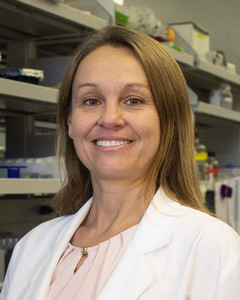 Stacy Brown, M.D.
Stacy Brown, M.D. Assistant Professor, Department of Medicine
I am a neurointensivist with clinical expertise in the management of neurologic emergencies including acute stroke. My research lies at the intersection of stroke epidemiology, vascular neurology, and population genetics. Motivated by observed population health disparities affecting stroke risk and outcome in the Pacific Islands, my project aims to evaluate how polygenic predispositions to diabetes and other cardiometabolic diseases influence risk of stroke in individuals of Native Hawaiian ancestry. I am also interested in how genetic variation related to cardiovascular disease impacts stroke survival, brain resilience, and functional outcomes after cerebrovascular injury.
 Abhijit Date, Ph.D.
Abhijit Date, Ph.D. Assistant Professor, Daniel K. Inouye College of Pharmacy, University of
Hawaiʻi at Hilo
Dr. Date’s research focuses on the improvement of biopharmaceutical properties of drugs indicated for the treatment of cardiometabolic disorders to improve their therapeutic efficacy. Dr. Date is currently involved in the development of strategies to improve biopharmaceutical properties and oral bioavailability of metformin, a front-line antidiabetic drug with poor cell permeability. More specifically, he is focusing on the physicochemical and structural modification of metformin and its subsequent encapsulation into nanoparticles to improve the oral bioavailability and therapeutic efficacy of metformin.
 S. Kapuaola Gellert, Ph.D.
S. Kapuaola Gellert, Ph.D. Assistant Professor, Department of Native Hawaiian Health
I am an epidemiologist with expertise in cardiovascular disease (CVD), and the population burden of CVD risk factors. Our research focuses on the effect of sleep deficiencies on CVD and cardiometabolic conditions including diabetes. We use epidemiologic methodologies to characterize the risk factors individually and in combination that are involved in the association between sleep deficiencies and diabetes. Our findings will elucidate important risk factors and biomarkers involved in sleep deficiencies and diabetes in Native Hawaiians thereby informing further research on sleep deficiencies and diabetes.
 Matthew Pitts, Ph.D.
Matthew Pitts, Ph.D. Assistant Professor, Department of Cell and Molecular Biology
My current research investigates the role of selenoproteins in two discrete populations of neurons, GABAergic parvalbumin (PV)-expressing interneurons and leptin receptor-expressing hypothalamic neurons. Redox imbalance in these two cell types has been implicated as key factors underlying neurodevelopmental disorders and obesity, respectively. With respect to diabetes, my work has identified selenoprotein M (SELENOM) as a novel factor that promotes hypothalamic leptin signaling and thioredoxin antioxidant activity. Current studies are being conducted to elucidate the molecular function of SELENOM with an emphasis on its influence upon mitochondrial bioenergetics and calcium homeostasis.
 Kathryn Schunke, Ph.D.
Kathryn Schunke, Ph.D. Assistant Professor, Department of Anatomy, Biochemistry, and Physiology
Disruption of cardiac parasympathetic activity is a common hallmark of a variety of cardiovascular diseases including type 2 diabetes (T2D). T2D is accompanied by a marked autonomic imbalance with sympathetic overactivity and reduced parasympathetic cardiac vagal activity. Reduced vagal drive to the heart is a strong independent risk factor for life-threatening arrhythmias, sudden cardiac death and microangiopathic comorbidities, while several experimental studies have shown that increased cardiac vagal activity exerts cardioprotective effects against these complications. The paraventricular nucleus of the hypothalamus (PVN) is an important site of autonomic control, and there are direct projections from the PVN to parasympathetic cardiac vagal neurons (CVNs) that co-release oxytocin. In an animal model of T2D, we will use an innovative chemogenic approach to selectively restore parasympathetic signaling to the heart by activating OXT neurons in the PVN of rats with viral vectors for oxytocin-driven cre recombinase along with floxed Designer Receptors Exclusively Activated by Designer Drugs (DREADDs). In this project, we will determine the molecular mechanisms of T2D-mediated autonomic dysregulation, and test whether chronic activation of PVN OXT neurons can restore these adverse changes.
 Michelle Tallquist, Ph.D.
Michelle Tallquist, Ph.D. Professor, Department of Medicine
The diabetic heart has localized inflammation that is accompanied by deposition of extracellular matrix (ECM) also known as fibrosis. In the presence of chronic fibrosis, contractile dysfunction occurs, often resulting in dilated cardiomyopathy. During the early phases of inflammation, immune cells and ECM secreting fibroblasts communicate with one another. Current models suggest that immune cells drive fibroblast activation. Few cardiac studies have investigated how fibroblast signaling impacts inflammatory cell behavior. The goal of our studies are two fold. The first is to determine if fibroblast signaling contributes to cardiomyocyte hypertrophy. Second we are investigating if loss of fibroblasts leads to enhanced inflammatory responses. Results from these studies will help to identify if fibroblasts play beneficial or detrimental roles in the progression of diabetic cardiomyopathy.
 Yiqiang Zhang, Ph.D.
Yiqiang Zhang, Ph.D. Assistant Professor, Department of Anatomy, Biochemistry, and Physiology
Diabetic cardiocomplications, such as cardiomyopathy and arrhythmias, are the leading causes of death. Despite the obvious impacts of diabetic cardiocomplications, a better understanding of this multi-factorial problem is lacking, and specific effective treatments remain elusive. With an ultimate goal to develop new therapeutics to treat cardiac dysfunctions in diabetes, I am studying epigenetic regulations underlying the disease remodeling of heart cells and related systems. We use novel stem cells and animal models, and precious patient biopsies, and advanced cell functional and molecular biology platforms in our study to understand the pathophysiology of diabetic heart diseases.
 Stacy Brown, M.D.
Stacy Brown, M.D. Michael Ortega, Ph.D.
Michael Ortega, Ph.D. Tyler Ray, Ph.D.
Tyler Ray, Ph.D.
 Alexandra M. Binder, Sc.D.
Alexandra M. Binder, Sc.D. Michael Corley, Ph.D. (graduated in 2020)
Michael Corley, Ph.D. (graduated in 2020) Nicholas James, Ph.D.
Nicholas James, Ph.D. Noemi Polgar, Ph.D.
Noemi Polgar, Ph.D. Tyler Ray, Ph.D.
Tyler Ray, Ph.D. Viola Pomozi, Ph.D. (graduated in 2018)
Viola Pomozi, Ph.D. (graduated in 2018) Alexander Stokes, Ph.D. (graduated in 2020)
Alexander Stokes, Ph.D. (graduated in 2020) Stacy Brown, M.D.
Stacy Brown, M.D. Abhijit Date, Ph.D.
Abhijit Date, Ph.D. S. Kapuaola Gellert, Ph.D.
S. Kapuaola Gellert, Ph.D. Matthew Pitts, Ph.D.
Matthew Pitts, Ph.D. Kathryn Schunke, Ph.D.
Kathryn Schunke, Ph.D. Michelle Tallquist, Ph.D.
Michelle Tallquist, Ph.D. Yiqiang Zhang, Ph.D.
Yiqiang Zhang, Ph.D. Mariana Gerschenson, Ph.D.
Mariana Gerschenson, Ph.D. Olivier Le Saux, Ph.D.
Olivier Le Saux, Ph.D. Takashi Matsui, M.D., Ph.D.
Takashi Matsui, M.D., Ph.D. Marjorie Mau, M.D.
Marjorie Mau, M.D.